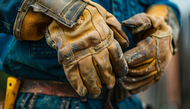Cut-Resistant Glove Ratings: Everything You Need to Know About ANSI Glove Ratings
25th Jun 2024
Hand safety is a top priority in various industries, and cut-resistant gloves are crucial in protecting workers from injuries. These gloves are designed to provide a barrier against cuts, abrasions, and punctures, ensuring workers can perform their tasks safely and efficiently.
The American National Standards Institute (ANSI) has established comprehensive standards for rating gloves' cut, puncture, and abrasion resistance, helping businesses choose the right protective gear for their needs.
Understanding ANSI glove ratings is essential for selecting the appropriate gloves for different applications. These ratings are based on rigorous testing methods that measure a glove's protection against specific hazards. In this guide, we will explore the ANSI cut-resistant glove ratings, puncture resistance levels, and abrasion resistance levels.
Detailed Explanation of ANSI Cut-Resistant Glove Ratings
The ANSI/ISEA 105-2016 standard is used to measure and classify the cut resistance of gloves. This standard introduced a detailed scale with nine levels (A1 to A9) to provide a more precise measurement of cut resistance. The testing method involves using a tomodynamometer (TDM-100 machine), which pulls a blade across the glove's surface under varying loads and measures the force needed to cut through the material. The results are averaged to assign a cut resistance level to the glove.
Here is a breakdown of the ANSI cut resistance levels:
- A1 (200-499 grams): Suitable for light tasks that involve minimal cut hazards, such as general handling and small parts assembly
- A2 (500-999 grams): Ideal for tasks requiring slightly higher cut resistance, like light-duty construction and material handling.
- Example: Ansell AlphaTec 58-20
- Example: Ansell AlphaTec 58-20
- A3 (1000-1499 grams): Common in environments with moderate cut hazards, such as automotive assembly and packaging.
- Example: Ansell RINGERS R07
- Example: Ansell RINGERS R07
- A4 (1500-2199 grams): Protects medium cut hazards, including metal fabrication, food processing, and handling sharp objects.
- Example: Ansell HyFlex 11-54
- Example: Ansell HyFlex 11-54
- A5 (2200-2999 grams): Used in industries with higher cut hazards, like sheet metal work and glass handling
- A6 (3000-3999 grams): Offers high cut resistance for tasks involving sharp materials and blades, such as meat processing and metal stamping
- A7 (4000-4999 grams): Suitable for environments with severe cut hazards, such as recycling and glass manufacturing
- A8 (5000-5999 grams): Provides high cut resistance for industries like mining and demolition
- A9 (6000+ grams): Maximum cut resistance, used in extreme-hazard environments, including heavy-duty metal work and high-risk industries.
ANSI Puncture Resistance Levels
ANSI puncture resistance levels are determined using a standardized test that measures the force required to penetrate glove material with a pointed probe. This test involves holding the glove fabric firmly between two plates and penetrating the fabric with a pen-like probe, which measures the resistance in newtons (N). The results are then converted to a scale from 1 to 5, where higher levels indicate greater puncture resistance.
Here is a breakdown of the ANSI puncture resistance levels:
- Level 1 (10-19 N): Provides minimal puncture resistance and is suitable for tasks with low puncture hazards, such as light-duty material handling.
- Level 2 (20-59 N): Offers moderate puncture resistance, ideal for handling materials that pose some puncture risk, such as plastic parts and small debris.
- Level 3 (60-99 N): Suitable for environments with higher puncture hazards, such as handling glass shards and certain construction tasks.
- Level 4 (100-149 N): Provides high puncture resistance, making it ideal for industries like recycling and waste management where there is a significant risk of puncture injuries.
- Level 5 (150+ N): Offers maximum puncture resistance, suitable for high-risk environments such as metalworking and heavy-duty industrial tasks.
ANSI Abrasion Resistance Levels
ANSI abrasion resistance levels are determined by subjecting glove materials to repeated abrasive actions until they wear through. This test involves scraping the glove fabric with abrasive weighted wheels and measuring the number of cycles (revolutions) needed to wear through the coating and liner. The results are then categorized on a scale from 0 to 6, where higher levels indicate greater abrasion resistance.
Here is a breakdown of the ANSI abrasion resistance levels:
- Level 0 (Provides minimal abrasion resistance, suitable for light tasks with low abrasion hazards.
- Level 1 (100-499 cycles): Offers basic abrasion resistance, ideal for tasks involving minor abrasive actions, such as light material handling and assembly work.
- Level 2 (500-999 cycles): Suitable for environments with moderate abrasion hazards, such as automotive assembly and packaging.
- Level 3 (1000-2499 cycles): Provides good abrasion resistance, making it suitable for tasks like construction and warehousing where moderate abrasive actions occur.
- Level 4 (2500-4999 cycles): Offers high abrasion resistance, ideal for industries such as metal fabrication and manufacturing with a significant risk of abrasion.
- Example: Ansell AlphaTec 37-155
- Level 5 (5000-9999 cycles): Suitable for high-risk environments like mining and heavy equipment operations where extensive abrasion resistance is required.
- Level 6 (10000+ cycles): Provides maximum abrasion resistance, making it ideal for extreme conditions and tasks involving heavy-duty abrasive actions.
- Example: Ansell HyFlex 11-735
Comparison with EN 388 Standards
While ANSI standards are widely used in North America, the EN 388 standard is commonly adopted in Europe for assessing the performance of protective gloves.
- Cut Resistance: EN 388 uses the Coupe Test (ISO 13997) to measure cut resistance, similar to the ANSI's TDM-100 machine test. The Coupe Test involves a rotating circular blade applied to the glove material under a fixed weight until it cuts through. However, for higher cut resistance levels (3-5), the ISO 13997 test is used, similar to the TDM-100 machine test used by ANSI.
- Puncture Resistance: EN 388 measures puncture resistance by applying a standardized puncture force using a pointed probe. The results are reported on a scale from 1 to 4.
- Abrasion Resistance: Abrasion resistance in EN 388 is determined by subjecting the glove material to a rotating abrasive wheel until it wears through. The levels range from 1 to 4, based on the number of cycles required to wear through the material.
- Tear Resistance: EN 388 also includes a test for tear resistance, which measures the force required to tear the glove material. The results are reported on a scale from 1 to 4.
Comparison Chart:
The Impact of Glove Material on Performance
The material used in cut-resistant gloves significantly affects their performance, comfort, and suitability for various tasks. Different materials offer unique benefits and limitations, influencing factors such as cut resistance, puncture resistance, abrasion resistance, dexterity, and overall user comfort.
- High-Performance Polyethylene (HPPE):
- Properties: Lightweight, flexible, high cut resistance, and good dexterity.
- Applications: Commonly used in manufacturing, automotive, and construction industries for tasks requiring protection and precision handling.
- Advantages: Provides excellent cut resistance without sacrificing comfort and flexibility.
- Limitations: May offer limited thermal protection and can be less durable against heavy abrasions.
- Kevlar:
- Properties: Strong, heat-resistant, high cut resistance, and good puncture resistance.
- Applications: Suitable for tasks involving heat and flame, such as welding, glass handling, and metal fabrication.
- Advantages: Provides superior cut and heat resistance, enhancing safety in high-risk environments.
- Limitations: Can be less comfortable and flexible compared to HPPE gloves.
- Stainless Steel Mesh:
- Properties: Extremely durable, high cut and puncture resistance.
- Applications: Ideal for food processing, meatpacking, and tasks involving sharp blades and tools.
- Advantages: Offers the highest level of cut and puncture resistance.
- Limitations: Heavy, less flexible, and can be uncomfortable for extended use.
- Nitrile Coating:
- Properties: Provides good grip, puncture resistance, and chemical resistance.
- Applications: Used in medical, laboratory, and chemical handling environments.
- Advantages: Enhances grip and provides chemical protection, making it suitable for handling oily or wet objects.
- Limitations: Can reduce breathability and may cause discomfort during prolonged use.
Final Thoughts on ANSI Glove Ratings
Understanding ANSI glove ratings is crucial for selecting the right cut-resistant gloves to ensure worker safety. These ratings provide a clear indication of a glove's ability to protect against cuts, punctures, and abrasions. By following a systematic approach to selecting gloves, considering the specific hazards of your work environment, and maintaining and inspecting gloves regularly, you can reduce the risk of hand injuries and enhance overall workplace safety.

